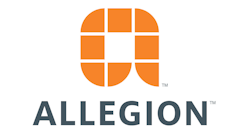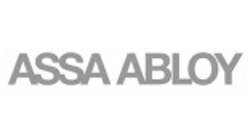This article originally appeared in the November 2020 issue of Security Business magazine. When sharing, don’t forget to mention @SecBusinessMag on Twitter and Security Business magazine on LinkedIn.
The future is touchless – that was the message from security industry heavyweights ASSA ABLOY and Allegion at the recent virtual ISC West show. Representatives of both companies delivered presentations during the event that covered much of the same ground with a few slight differences; however, the big takeaway is that touchless door openings will be a major part of each company’s strategy for the foreseeable future.
Noting how the COVID-19 pandemic has led more than 60 percent of the U.S. and Canadian workforce to work from home, “it demands a great amount of creativity and innovation to navigate this crisis,” said Mark Duato, executive vice president of Aftermarket Solutions for ASSA ABLOY Door Security Solutions.
It also, evidently, requires a fair number of products. To that end, both companies have come up with collections that bring together a wide group of products under one banner. Allegion calls them “Solutions for Healthy Environments,” while ASSA ABLOY has a more formal branding name: Safer2Open.
Most of these solutions have become familiar in the past few months, such as low-energy door operators, motion sensors and touchless actuators; however, the lines also include low-tech products, such as foot and arm pulls.
“Often times when you hear the term ‘touchless opening,’ you think about the Star Trek door, and, well, that’s at one end of the continuum,” said Peter Boriskin, CTO of ASSA ABLOY Opening Solutions. “Not every door is the same.”
Boriskin noted that in cases of high-traffic doors, such as at a hospital or a school entrance, it makes more sense to have a higher tech – and higher cost – particularly when there might be Americans with Disabilities Act considerations. On the other hand, for doors that have more infrequent use, it makes less sense to have an automatic or even electronic solution.
It comes down to a mix of priorities and budget. And those budgets have become tighter in recent days to the point where businesses might not have the funds to pay for electronic upgrades. “It’s about just helping the end-users understand what their options really are,” said Brad Sweet, commercial marketing leader at Allegion.
“If (integrators) are able to ask good questions and understand the needs of the customer, then being able to provide them with a few different options of how to accommodate or address their concerns is really important,” Duato said.
Solutions for Healthy Environments
Although the message and tone of the presentations were the same, the two companies vary a bit in the specifics. Allegion breaks its approach into three groups, of which only the third one is actual touchless and low-touch products it offers through its Schlage, Von Duprin and Ives brands.
The first one is simple cleaning and disinfecting — the first line of defense in stopping the spread of germs. In particular, Allegion reminds end users that abrasive cleaners can break down door hardware and damage physical credentials over time.
“Mild soap and water,” Sweet said is the correct method, adding that Allegion has been trying to provide basic guidance and information on how to handle the pandemic since the early spring. This is just one of many options that companies have to promote health around the door.
“It offers up various ranges of investment,” he said. “If you think about cleaning, that’s an operational cost,” and companies are more likely to have those costs in their budget. However, when you start to talk about changing or adding door hardware, then it becomes a capital expense, and funds for that might or might not be available.
Allegion’s second group crosses the line into capital expenditures at a lower level. This group, which is called alternative surface technologies, concedes that some touching of the door might be necessary, particularly in lower traffic situations. However, when touching is necessary, the door hardware includes technology that provides some protection against the spread of germs.
Several manufacturers offer antimicrobial coatings as an option in their exit devices, levers and locks, including Allegion. However, Allegion has gone one step further by offering an additional option in the form of an alloy that includes copper. (Typical antimicrobial coatings contain silver ions.)
“It’s actually a product that has been out there in the health-care environment for a while as a coating that you find on bed rails, on bedside tables, on IV poles and things like that,” said Kim Haymaker, Allegion product marketing manager of commercial electronic locks and system components. “We’ve employed that on certain products within our portfolio as a means of mitigating certain bacteria.”
The U.S. Environmental Protection Agency acknowledges that certain copper-containing alloys are antimicrobial. Independent testing that shows that these alloys when cleaned regularly kill more than 99.9 percent of certain bacteria within 2 hours of exposure at room temperature, including MRSA and the bacteria that cause staph infections.
Allegion’s option was developed with Aereus Technologies and is an option on limited Von Duprin, Ives and Schlage products. It will have a higher cost than standard antimicrobial coating, Sweet acknowledges.
Safer2Open
ASSA ABLOY’s marketing of a group of products by its various divisions was aimed at the pandemic, but Boriskin and Duato expect that Safer2Open will remain a focus for the company long after COVID-19 fades.
“Hospitals, schools, any places that you have lots of people coming together, they are always focused on how they can reduce infections and how they can make their buildings safer and healthier,” Boriskin points out. “On the other side, where folks are seeing the convenience of a touchless solution — I don’t think those things are going to go away.”
What that means is more opportunities for locksmiths and security pros. As budgets increase, security pros would do well to focus on these three areas:
- Frictionless access control
- Workforce management
- Emerging areas
Frictionless access control is a relatively new term that means making access easy while maximizing security. Increasingly, it also takes touchless control into account. Two technologies that will be a significant part of this push for frictionless access control are familiar and widespread — smartphones and wireless hardware.
A third one that ASSA ABLOY is starting to discuss is ultra-wideband (UWB) technology. UWB is a low-energy, short-range radio-frequency form of communication that began to appear in smartphones in 2019, and Duato said it can be deployed to improve access control functionality. It wouldn’t replace Bluetooth or near field communication but complement it.
Boriskin said the company showed a few UWB solutions connecting to door operators at the Consumer Electronics Show in January 2020, “and there was a lot of interest in it.” Although ASSA ABLOY has no new products to announce, “those are the kinds of things I think you should expect to see from us,” he adds.
As for workforce management, that term has several potential ramifications during the pandemic. There’s the desire to control how many people are in close quarters, such as by proximity monitoring, to try to maximize safety, but the workspace itself also might be affected. Duato mentions locker management for a transitory workforce as an example.
“For those who come in a few days per week, they may need the ability to place belongings into secure places, a locker of some sort,” Duato said. Businesses would have to be able to create and change access credentials to these lockers in “a fast way.” How? Through smartphones and wireless locks.
With respect to emerging areas that will demand more attention, Duato names unmanned critical infrastructure, such as remote traffic management, as one of three key applications because of the number of such sites that aren’t as secure as they could be. The others are intelligent power supplies and untraditional openings, such as data centers.
Just be flexible with respect to solutions, because, as Boriskin said, “not one size fits all.”
Will Christensen is Senior Editor of Locksmith Ledger International magazine (www.locksmithledger.com), a sister publication and website to SecurityInfoWatch.com and Security Business.




